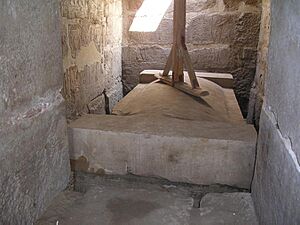Takelot I facts for kids
Quick facts for kids Takelot I |
|
|---|---|

The Sarcophagus of Takelot I
|
|
| Pharaoh | |
| Reign | 885–872 BC (Dynasty XXII) |
| Predecessor | Shoshenq II or Tutkheperre Shoshenq |
| Successor | Osorkon II |
| Consort | Kapes |
| Children | Osorkon II |
| Father | Osorkon I |
| Mother | Tashedkhonsu |
| Died | 872 BC |
Hedjkheperre Setepenre Takelot I was an ancient Libyan ruler. He became a pharaoh during the Twenty-second Dynasty of Egypt. His reign lasted from about 885 BC to 872 BC.
Contents
Who Was Pharaoh Takelot I?
Takelot I was the son of Osorkon I and Queen Tashedkhonsu. He ruled Egypt for about 13 years. Takelot I married Queen Kapes, and they had a son named Osorkon II, who later became pharaoh.
Discovering Takelot I's Reign
For a long time, experts thought Takelot I was not a very important pharaoh. They found few records or buildings from his time. One of the only mentions was on a famous stone called the Stela of Pasenhor. This stela was made much later, in the 37th year of King Shoshenq V.
However, in the 1980s, Egyptologists (people who study ancient Egypt) found new information. They realized that some old documents mentioned a king named Takelot. These documents were actually about Takelot I, not another king named Takelot II. This helped them learn more about his rule.
How Was Takelot I Different from Takelot II?
Both Takelot I and Takelot II used the same royal name, Hedjkheperre Setepenre. This made it tricky for historians to tell them apart. But there was a key difference. Takelot I never used the title Si-Ese, which means "Son of Isis." Takelot II always used this title.
Another clue was how their names were written. Takelot I's name often used a specific tall 't' symbol. Takelot II's name used a different, smaller 't' symbol. These small details helped experts correctly identify which king was which.
Where Was Takelot I Buried?
Takelot I was buried in a royal tomb at Tanis, an ancient city. This tomb was partly robbed before it was discovered.
Evidence from the Tomb
Inside Takelot I's burial place, archaeologists found special items. These items helped confirm it was his tomb. They found a gold bracelet and an alabaster jar that belonged to his father, Osorkon I. They also found a small statue (called an Ushabti) of his mother, Queen Tashedkhonsu.
A heart scarab (a type of amulet) found in the tomb also had his name, "Takelot Meryamun." It did not include the "Si-Ese" title, which confirmed it was Takelot I.
Osorkon II's Tribute to His Father
In 1987, a German scholar named Karl Jansen-Winkeln studied the writings on the tomb walls. He proved that the tomb belonged to Takelot I. His son, Osorkon II, had these words carved in his own tomb. The carvings showed Osorkon II honoring his father.
The text says that Osorkon II made sure his father, Takelot I, rested in a special place near the god Amun. This shows that Osorkon II respected his father greatly. Osorkon II even buried his father within the walls of his own tomb complex. Takelot I was placed in an older sarcophagus (a stone coffin) that had his name carved on it.
Challenges to Takelot I's Power
Takelot I's power was not strong everywhere in Egypt. Especially in Upper Egypt, his authority was challenged.
Rival Kings and Priests
In the city of Thebes, a local king named Harsiese A might have challenged Takelot I. There were also important priests of Amun, Iuwelot and Smendes III, who were Takelot I's brothers. They recorded events on the Nile Level Texts (records of the Nile River's height) in Thebes. These texts mentioned years 5, 8, and 14 of an unnamed king. This unnamed king was most likely Takelot I.
However, the texts did not mention the king's name directly. This suggests there might have been a disagreement about who should be pharaoh after Osorkon I died. The priests in Thebes may have chosen not to pick a side in this royal argument. This way, they avoided getting involved in the conflict. Eventually, Osorkon II became pharaoh and was clearly recognized in Thebes by his 12th year of rule.

